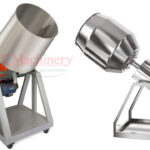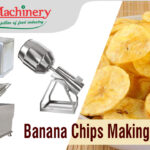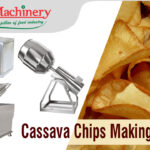Introduction: From Farm to Crispy Delight
Potato chips, the beloved snack enjoyed by millions worldwide, owe their irresistible taste and texture to a meticulous manufacturing process. This process transforms humble potatoes into crispy, savory delights through advanced technologies and techniques. In this comprehensive guide, we’ll explore the step-by-step process behind potato chip making, the advanced technologies involved, and how businesses can streamline production to deliver superior products to consumers.
Step 1: Raw Material Selection – Picking the Perfect Potatoes
The foundation of high-quality potato chips lies in selecting the right raw materials. Potatoes with high starch content and low moisture levels, such as Russet or Atlantic varieties, are ideal. These potatoes ensure crispiness and consistent texture after frying. Key characteristics to consider:
- Size and Uniformity: Larger potatoes allow for uniform slicing.
- Low Sugar Levels: Prevents excessive browning during frying.
- Free from Defects: No bruises or green spots, ensuring the best flavor and appearance.
Learn more about advanced sorting systems on our Chips Making Plant page.
Step 2: Washing and Peeling
Once sorted, potatoes are washed thoroughly to remove dirt and impurities. Mechanical or abrasive peeling machines then strip off the skin without wasting the edible portion. This step ensures a clean, smooth surface, crucial for uniform frying and seasoning.
For details on advanced washing and peeling machines, visit our Food Processing Equipment page.
Step 3: Slicing – Precision for Perfect Chips
The peeled potatoes are sliced into thin, uniform pieces using specialized slicing machines. The slice thickness, typically between 1 to 1.5 millimeters, determines the texture of the final chips. Rippled blades are often used to create ridged chips, enhancing crunch and flavor retention.
Check out our Potato Chips Making Plant page to learn about advanced slicers.
Step 4: Rinsing and Drying – Reducing Starch and Moisture
Potato slices are rinsed in cold water to remove excess starch, which helps achieve crispiness during frying. After rinsing, slices are dried using air dryers to minimize oil absorption, ensuring lighter and less greasy chips.
Step 5: Frying – The Heart of the Process
Frying is the most critical step in potato chip production. Slices are immersed in high-quality oil heated to 160°C to 180°C (320°F to 356°F). This precise temperature range ensures:
- Rapid evaporation of moisture.
- Gelatinization of starch for crisp texture.
- Golden color and rich flavor through the Maillard reaction.
For more on advanced frying systems, visit our Products by Applications page.
Step 6: Flavoring and Seasoning
Post-frying, the chips are seasoned while still warm, allowing flavors to adhere uniformly. Common seasonings include:
- Classic salted.
- Spicy masala.
- Cheddar cheese.
Discover our seasoning equipment on the Video Gallery page.
Step 7: Cooling and Packaging – Preserving Freshness
The fried and seasoned chips are cooled to room temperature before being packed. Packaging plays a vital role in maintaining freshness and crispness. Nitrogen-flushed bags are used to prevent oxidation and extend shelf life.
Explore our automated packaging solutions on the Chips Making Plant page.
Advanced Technology in Potato Chip Plants
Modern potato chip plants rely on automation and innovative machinery to optimize efficiency and quality. Key equipment includes:
- Peeling Machines: Abrasive or chemical peeling for minimal waste.
- Slicers: Adjustable blades for precise thickness.
- Fryers: Oil filtration and temperature control systems.
- Seasoning Machines: Uniform flavor application.
- Packaging Machines: Nitrogen-flushed sealing for extended freshness.
Learn more about our comprehensive machinery range.
Benefits of Fully Automated Potato Chip Plants
- Efficiency: Automation reduces labor costs and ensures faster production.
- Consistency: Uniform slicing, frying, and seasoning maintain product quality.
- Hygiene: Advanced systems adhere to food safety standards.
- Customization: Machines can be adjusted for different chip types and flavors.
FAQs About Potato Chip Manufacturing
Q: What is the optimal frying temperature for potato chips? A: The ideal frying temperature ranges from 160°C to 180°C to ensure crispness and golden color.
Q: How does nitrogen-flushed packaging extend shelf life? A: By replacing oxygen with nitrogen, packaging prevents oxidation, preserving freshness and crispness.
Q: What equipment is essential for a potato chip production line? A: Key equipment includes washing and peeling machines, slicers, fryers, seasoning machines, and packaging systems. Explore options on our website.
Q: Can one plant produce multiple chip varieties? A: Yes, by adjusting slicing thickness, frying time, and seasoning, manufacturers can produce various chip types.
Conclusion: Investing in Quality Machinery for Superior Chips
The journey of a potato from field to plate involves precision, innovation, and advanced technology. By investing in a high-quality potato chip making plant, manufacturers can ensure consistent product quality, enhanced efficiency, and greater customer satisfaction. Visit Blaze Machinery to explore our wide range of food processing equipment.
Ready to take your chip production to the next level? Visit our blog for more insights or contact us for customized solutions.











Recent Comments